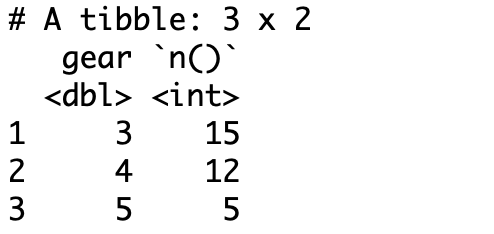
These all combine naturally with groupby() which. Supply wt to perform weighted counts, switching the summary from n n() to n sum(wt). count() is paired with tally(), a lower-level helper that is equivalent to df > summarise(n n()). arrange() changes the ordering of the rows. count() lets you quickly count the unique values of one or more variables: df > count(a, b) is roughly equivalent to df > groupby(a, b) > summarise(n n()). sum adds numbers, n () and count () count rows. These functions solved a pressing need and are used by many people, but are now superseded. 0.307 9 Furniture 0.0360 0.112 10 Furniture 0.0360 0.112 with 4,555 more rows. With R, you can aggregate the the number of occurence with n (). Prior versions of dplyr allowed you to apply a function to multiple columns in a different way: using functions with if, at, and all() suffixes.


Library ( dplyr ) starwars %>% filter ( species = "Droid" ) #> # A tibble: 6 × 14 #> name height mass hair_color skin_color eye_color birth_year sex gender #> #> 1 C-3PO 167 75 gold yellow 112 none masculi… #> 2 R2-D2 96 32 white, blue red 33 none masculi… #> 3 R5-D4 97 32 white, red red NA none masculi… #> 4 IG-88 200 140 none metal red 15 none masculi… #> 5 R4-P17 96 NA none silver, red red, blue NA none feminine #> # ℹ 1 more row #> # ℹ 5 more variables: homeworld, species, films, #> # vehicles, starships starwars %>% select ( name, ends_with ( "color" ) ) #> # A tibble: 87 × 4 #> name hair_color skin_color eye_color #> #> 1 Luke Skywalker blond fair blue #> 2 C-3PO gold yellow #> 3 R2-D2 white, blue red #> 4 Darth Vader none white yellow #> 5 Leia Organa brown light brown #> # ℹ 82 more rows starwars %>% mutate ( name, bmi = mass / ( ( height / 100 ) ^ 2 ) ) %>% select ( name : mass, bmi ) #> # A tibble: 87 × 4 #> name height mass bmi #> #> 1 Luke Skywalker 172 77 26.0 #> 2 C-3PO 167 75 26.9 #> 3 R2-D2 96 32 34.7 #> 4 Darth Vader 202 136 33.3 #> 5 Leia Organa 150 49 21.8 #> # ℹ 82 more rows starwars %>% arrange ( desc ( mass ) ) #> # A tibble: 87 × 14 #> name height mass hair_color skin_color eye_color birth_year sex gender #> #> 1 Jabba De… 175 1358 green-tan… orange 600 herm… mascu… #> 2 Grievous 216 159 none brown, wh… green, y… NA male mascu… #> 3 IG-88 200 140 none metal red 15 none mascu… #> 4 Darth Va… 202 136 none white yellow 41.9 male mascu… #> 5 Tarfful 234 136 brown brown blue NA male mascu… #> # ℹ 82 more rows #> # ℹ 5 more variables: homeworld, species, films, #> # vehicles, starships starwars %>% group_by ( species ) %>% summarise ( n = n ( ), mass = mean ( mass, na.rm = TRUE ) ) %>% filter ( n > 1, mass > 50 ) #> # A tibble: 8 × 3 #> species n mass #> #> 1 Droid 6 69.8 #> 2 Gungan 3 74 #> 3 Human 35 82.8 #> 4 Kaminoan 2 88 #> 5 Mirialan 2 53. summarise() reduces multiple values down to a single summary. For this, I turn to none other than dplyr s across function.


 0 kommentar(er)
0 kommentar(er)
